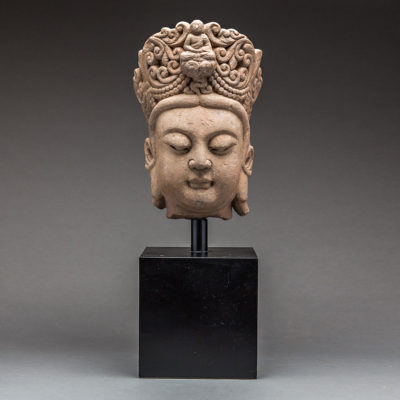
| SKU | AM.0335 |
|---|---|
| Circa | 1368 AD to 1644 AD |
| Dimensions | 12.25″ (31.1cm) high x 8.25″ (21.0cm) wide |
| Medium | Stone |
| Origin | China |
| Gallery Location | UK |
Buddhism was introduced to China from India in the early years of the first millennium. This head represents the bodhisattva of mercy, known as Avalokiteshvara (or Guanyin in Chinese). Bodhisattvas were originally depicted as the Buddha’s attendants but increasingly came to be venerated in their own right. Usually dressed in elaborate attire, they were enlightened beings who had chosen to delay their entry into Nirvana to help other sentient beings end the cycle of birth and rebirth. Avalokiteshvara is identifiable by the small seated Buddha that appears in the headdress. This figure was immensely popular in China and it has been estimated that by the Tang period the number of images depicting Avalokiteshvara outnumbered those of the historical Buddha Shakyamuni. Although Buddhist texts do not specify the gender of bodhisattvas, the early examples tend to be male. From the end of the Song dynasty (1279) this trend was reversed and by the Ming period such images are clearly feminine.
Representing a fragment from a larger piece, the head is still striking for the facial expression and the technical virtuosity of the carving. The headdress in particular is an artistic tour de force, with deeply carved foliate trails and a beaded trim. The hair is parted in the centre and frames the face in two smooth bands. The almond shaped eyelids are almost closed in a gesture of meditation but the well-defined lips have the suggestion of a smile- reminding us of this bodhisattva’s approachability and compassion.
Login to view price
Sign-up to receive the latest Wedding Estates news and promotions!

